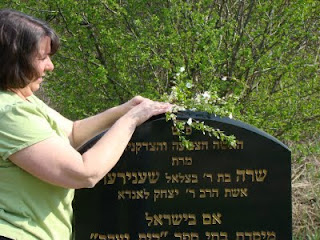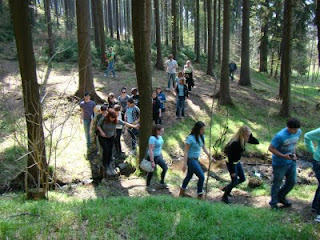
Today we spent the day with our guide, Ewa, walking and learning the history of Krakow and the Wawel Castle district. After walking through the square, we walked up the hill to Wawel. The flowers are in full bloom everywhere, on this sunny, beautiful day.

We enter the Wawel Cathedral, and silently walk through, since many people are inside praying today, Good Friday. Here is the burial place of Polish kings and rulers. We visit downstairs, underneath the cathedral, where the sarcophogus of Jan Kazynski and his wife, who were killled in the plane crash last year at this time.

From here, we walk down the hill toward Jagellonian University, the oldest university in Poland. We enter into a guided tour of this place, where students once included Copernicus and John Paul II.

From here, we go back to the square, and enjoy and afternoon that includes lunch and shopping for souvenirs from beautiful, hospitable Krakow.

Final Reflections Holocaust Study Tour 2011
Sarah S. says ... The Holocaust Study Tour was definately an experience I will never forget. I laughed, I cried, and discovered my identity. I have gained more knowledge of my heritage, more common sense, and more friends. Celebrating a Jewish holiday in a Jewish community in the Czech Republic was the highlight of my trip that will stay with me forever. Thank you to all of the teachers and my family members for making this possible, but most of all, my grandfather.
Sarah P. says ... This trip provided experiences that I would have never imagined being in. Although the places and locations were distinct on their own, the emotions they provided varied from anything I have ever felt before. Willingness from survivors and the exposure of Holocaust sites unfolded a tragic history that was new to me.
Saidie says ... Given the oppotunity to actually come to Europe is incredible by itself. Adding the information learned and places seen makes it even better. Knowledge was obtained and emotions were everywhere. This made me comprehend the Holocaust history much more than I could imagine. This was an experience of a lifetime and opened my eyes much more and taught me things that a textbook and the internet cannot.
Brenton says ... This trip has been absolutely extraordinary. The things you see and discuss as a group on this tour cannot be experienced in a classroom. This trip has given me the ability to view my own life and the lives of others from a whole new perspective.
Ashley says ... I have learned so much these past two weeks. I have a new view on life. This trip was a once-in-a-lifetime experience that I will never forget.
Theresa says ... This trip definitely taught me a lot about the history of the Holocaust, the importance of life, and who I am. I thought I was so prepared, but it turned out I wasn't emotionally prepared for all we saw. I am so grateful I got to go on this life changing trip because not only did I learn a lot, but I gained 21 new friends.
Francesca says ... Coming on this trip I really had no idea what to expect. After spending two weeks here I can honestly say it changed my outlook on life. It was definitely an experience of a lifetime that I would do again.
Deanne says ... These past two weeks were a learning experience of a lifetime. As our trip comes to an end, I reflect on everything I was taught, my new friendships and a whole new perspective on history.
Michelle says ... As cliche as it might sound, I have really seen the beauty of freedom and life itself. But most importantly, I have learned the importance of forgiveness and the strength to move on from the past.
Jessica says ... Of all the things I have done in my life, this trip has been the most significant. There wasn't a moment where I wasn't learning something. I can honestly say I look at the Holocaust in a completely different way and I will use my knowledge to make sure it never happens again.
Celina says... This trip has really opened my eyes to the acceptance of one's past. Countries affected by the Holocaust have utilized their past histories to teach others tolerance. I am now firmly committed to my goal of working with global development because I have seen what indifference really is and how one indvidual can change the world for better or for worse.
Nick says ... Condensing the lessons that I have learned from this trip into one succinct paragraph is nearly impossible -- there have been so many noteworthy things this trip has granted me. Not only have I gained a much deeper understanding of the Holocaust I have been exposed to cultures of Europe. This experiential learning opportunity has allowed our group to learn about humanity and its potential. It is clear to me that it is our responsibility to pass on the knowledge of the Holocaust.
Reagan says ... The most fascinating and important thing I learned on this trip is what warning signs lead to such a tragedy. However small the action, all acts of dehumaization and intolerance can lead to catastrophic conclusions. By dissecting the choices made during this complex and heartbreaking event, we can understand what roads to avoid as a society.
Cherilyn says ... This trip has opened my mind to so much new knowledge and has inspired me to learn even more. I have learned so much about the Holocaust and European history that I was unaware of before. I am so thankful to have had the opportunity to go on this once-in-a-lifetime learning experience.
Sammy says ... Going on this trip and learning as much as we did was truly a life changing experience. We haven't even gotten home yet, but I know I am going to be an entirely different person. I will never forget all that I saw, everything that Shalmi taught us and all that I have learned about myself.
DaiQuan says ... The Holocaust Study Tour trip gives an opportunity to students to learn the history of Europe. It gives students an opportunity to change minds for the better. This trip gives knowledge and emotions to empathize with people who were persecuted during the Holocaust.
Casey says ... This once-in-a-lifetime experience is one I will never soon forget. I have learned so much about the Holocaust, myself, and others. I have made amazing friends and had so much fun learning about things you would never find in a textbook. I am so grateful to have been given this opportunity to go on this trip.
Lilibeth says ... This trip is a milestone in my life. It gave me the power and inspiration to change myself and the world around me. It has given me the knowledge and power to give hope to our new generation and keep our history alive and well-known.
Kasandra says ... Just like what I had intended it to be, this trip has opened my eyes to a whole new world of so much history. It taught me about not only the Holocaust, but the history of visited cities, and how much we take for granted. These past two weeks brought me to the conclusion that this is a once-in-a-lifetime adventure and I am so grateful to have been a part of it!
Greg says ... This trip has been a unique learning experience. I have learned so much history about the Holocaust and Europe and I have experienced a great deal of European culture. Now that the this trip is almost over, I have so much knowledge about myself and the Holocaust that I can apply to my own life.
Mackenzie says ... Unforgettable -- that is the best way to describe my experience. The Holocaust Study Tour taught me more than I ever hope to know about not only the Holocaust, but also the European countries involved at the time. During two intense educational and exciting weeks, 22 students, 4 teachers and Shalmi came together to form a tight-knit family of which I am so grateful to be a member.
Jordan says ... I have been so lucky to have the opportunity to go on such an amazing trip. I have learned so much more about the Holocaust than ever before. This trip has changed my outlook on life and inspired me to continue my learning about the Holocaust.





















































